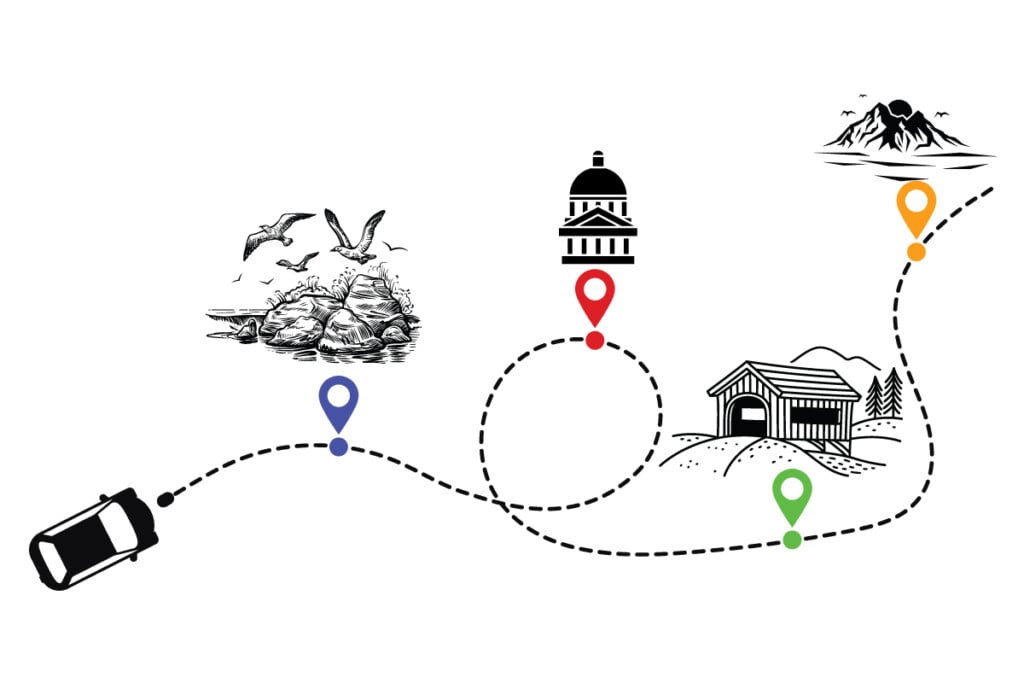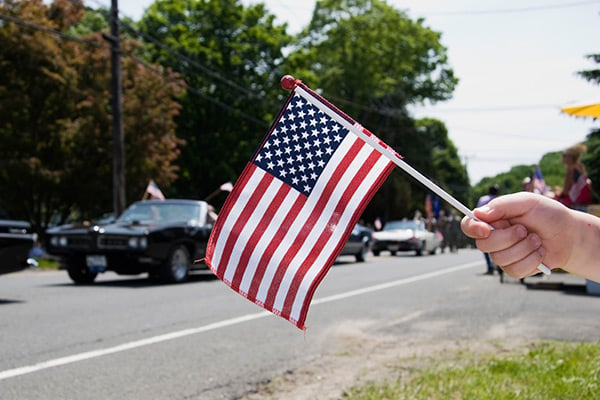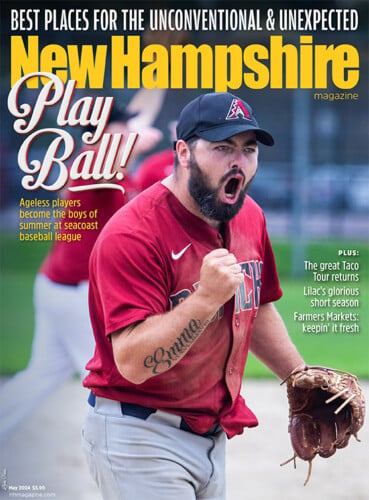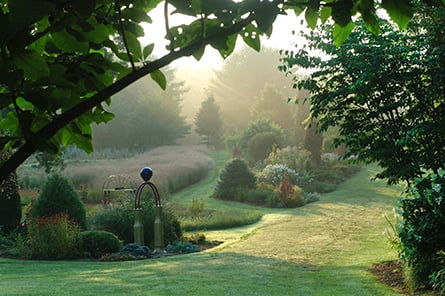Rediscover Robert Frost
What distinguishes poetry from prose is a mystery best revealed by reading, but the rocky boundaries between those forms was carefully surveyed by our own most famous poet: Robert Frost

Illustration by Kirstie Koeppl
Editor’s note: Throughout this story you’ll see illustrations inspired by Robert Frost and his poetry. These illustrations were created by students in Associate Professor Ryan O’Rourke’s Community Illustration Studio at the Institute of Art and Design at New England College. This is our third collaboration with O’Rourke’s students, and you can learn more about this ongoing partnership here.
One hundred years ago (next year) Robert Frost left New Hampshire.
With characteristic flourish, he told a friend he was abandoning Franconia, where he had lived since 1915, because it was too cold for his beloved apple trees. The Franconia years correspond to a trough in the poet’s career, whose initial crest, between 1913 and 1916, had seen the rapid-fire output of three books containing some of his best and best-known poems. The three succeeding years saw only six of his poems appear in print. Now in his late 40s, Frost worried that he had aged out of the poetic sensibility, or that his literary gift was somehow ineradicable from his old farm in Derry, long since sold.
In the three years after he left New Hampshire, however, he published 37 new poems, a streak that culminated in the release of a fourth book entitled, with a backward glance, “New Hampshire.” It was the first book consisting primarily of material he’d composed since becoming a professional poet, and it led off with a sprawling and obscure title monologue professing to be about the place he loved most. But by then, as the poem itself announces, he was living in Vermont.
Less than two years after his relocation, the Vermont State League of Women’s Clubs named Frost its state’s poet laureate. The assessment that appeared in The New York Times might well have been filed by a skeptical New Hampshire onlooker:
“If one of our States is to have a poet laureate, a natural expectation is that he would be a native, or, at the very least, a long-time resident of that State. It is more than a little curious, and an incitement to considerable thought, therefore, that the Vermont State League of Women’s Clubs, in annual convention this week, selected ROBERT FROST to be Vermont’s official representative of the Muses.”
There’s a tradition of teasing between Vermont and New Hampshire, and although most of it stems from differences that emerged after Frost’s time, the famously mischievous poet was fond of rivalries and would likely approve. But New Hampshire can no more claim Robert Frost (which it does) than he could claim to speak for New Hampshire (which he did). For one thing, Frost scarcely distinguished between New Hampshire and Vermont: “Anything I say about New Hampshire / Will serve almost as well about Vermont, / Excepting that they differ in their mountains.” They were both his beloved “North of Boston” country — a felicitous phrase he nabbed from the city real estate listings. More importantly, the New Hampshire of Frost’s poetry is not a geographical but an imaginary state, a transcendent place the poet inhabited when he was at work.
“I think there are two kinds of local feeling in poetry,” Frost’s frenemy T.S. Eliot once said. “There is one kind which makes that poetry only accessible to people who’ve had the same background, to whom it means a great deal. And there is another kind which can go with universality: the relation of Dante to Florence, of Shakespeare to Warwickshire, of Goethe to the Rhineland, the relation of Robert Frost to New England.” The imaginary yawn between the real Frost and the real New Hampshire is the stage on which Frost’s poetry becomes universal.
It’s in his first three books — “A Boy’s Will “(1913), “North of Boston” (1914), and “Mountain Interval” (1916) — that this space is initially given its working form. Biographically speaking, it is fair to regard 1900 to 1920, the long season of that gem-studded trilogy, as Robert Frost’s New Hampshire phase — even as we recognize that two and a half crucial years were spent in England, and that his New Hampshire ties reach back much further.
For Frost, New Hampshire, and Derry especially, was a touchstone, almost a talisman. “To a large extent the terrain of my poetry is the Derry landscape, the Derry farm,” he wrote to a friend decades later. “Poems growing out of this, though composite, were built on incidents and are therefore autobiographical. There was something about the experience at Derry which stayed in my mind, and was tapped for poetry in the years that came after.” When he tried later to make poetry out of the real Robert Frost touching real places, the result was often failure.
The best poems in those first three books were drafted on the farm in Derry between 1900 and 1910 (a few even earlier). Frost’s ability to extract universal poetry from specific places and concrete episodes is nowhere as consistently strong as in these books. His major themes first shine through here, sometimes already in well-developed form: meaning as a product of a precisely tuned tension between two opposing forces; the need to impose form to be able to recognize meaning in a basically confusing universe; and the idea of moving forward by looking backward.

Robert Frost lived at the farm in Derry (above) from 1900-1911, and then at the Franconia farm from 1915-1920, though he and his family spent summers there for almost 20 years. Today, you can visit both the The Robert Frost Farm (Derry) and The Frost Place (Franconia). Photo courtesy of the University of New Hampshire
The farm in Derry was essentially a bribe paid by Frost’s grandfather, who hoped his 26-year-old grandson would put away his dreams of being a poet and earn his keep, even if it only meant raising chickens. Frost always worked hard to look like an idler. He relished a pose, especially when it made him seem less than he was: “It takes tremendous nerve to be willing to look as if you don’t know what you’re doing,” he once said, “when in fact you’re a master of the activity in question.” But it was obvious from early days that he was no slouch. He’d been valedictorian of his high school class, despite a heavy classical curriculum, and all his life he kept the habit of studying and composing late into the night. To be sure, he cherished his idle time and regarded it as indispensable to good writing. Nevertheless, he made the farm go as well as necessary for a few years, then distinguished himself sufficiently in teaching to earn an invitation to instruct at the Normal School in Plymouth.
After an unfulfilling year there, however, and feeling the itch of ambition, Frost and his wife, Elinor, decided to leave New England for a time, in hopes that a change of scene might catalyze his poetic career. They considered Vancouver and New York City but finally settled on England, a decision for which Frost had one of his picturesque standard explanations. They chose England, he liked to say, because Elinor had wanted to “live under thatch.” Whether or not it was the thatch, England proved the incubator Frost needed to hatch his first three books of New Hampshire poems.
Two of the most celebrated lyrics in “A Boy’s Will,” Frost’s first book, can be read as expressions of a tension that marked his life in Derry, between hard work and studied idleness, and, more generally, as an instance of the way Frost used tension to illuminate reality. “Mowing,” arguably Frost’s finest achievement, is a tightly controlled sonnet and near-perfect expression of his notion, derived from Thoreau, of fact as the purest stuff of poetry. The poem centers on a scythe whispering as it cuts hay. Like the scythe, the poem whispers. On a ground level, the narrator exhibits an intimacy with toil, where there is no surplus of mental energy for imagination, and all one can dream of are concrete facts. To such an absorbed mind, the mere sound of the scythe has a sweetness to it, which Frost gives us in susurrant strings of sibilant syllables. On another level, we can take “fact” in its historical sense — an achievement, a deed — and understand the poem itself as the realization of a sweet dream resulting from the poet’s mental labor. The fact of the whispering scythe transcends its purpose to become the fact of a whispering-scythe-shaped poem.

Illustration by Kirstie Koeppl
If “Mowing” is poetry of fact, “The Tuft of Flowers” is poetry of fancy. Strikingly, the setting is the same (although the “The Tuft of Flowers,” written years earlier, attaches to a Windham farm on which Frost briefly worked), but here “the long scythe whispering to the ground,” a repeated scrap of verse that unmistakably links the two poems, is a product of the narrator’s imagination. He has slept later than the mower and come to turn the cut hay so it can dry in the afternoon sun. It’s reasonable to think of the two characters as facets of the poet’s divided self. But the narrator in the second poem is easily distracted from his work when his eyes fix on a passing butterfly, which eventually steers his gaze toward a tuft of flowers. He imagines that the mower, in a moment of elation, left the flowers standing, never knowing that his gesture would produce an overpowering feeling of kinship in someone else. This coming together of the poems might seem an accident, but we can be sure it is not.
Robert Frost’s shorter works are among the best-known poems in English, widely misquoted and crassly misunderstood, which are both marks of popularity. “Mending Wall,” which appears early in “North of Boston,” has suffered particularly on this account. The enthusiasm it engenders can even blind readers to the basic laws of grammar. On a visit to the Robert Frost Farm State Historic Site in Derry, I was told by an employee, “On your walk around the farm, you’ll go past the actual mending wall!” I nearly said, “What’s a mending wall?”
“Something there is that doesn’t love a wall,” the poem begins. The anarchic line crumbles as it leaves the mouth, like the boulders spilt in the sun, itself a manifestation of the entropic “something” that undermines the wall. This unknown force is neither good nor bad; it is simply the order, or disorder, of things. At the same time, there is an opposite something that doesn’t hate a wall — something that compels the narrator to call on his neighbor over the hill and let him know it’s mending time.
The poet and critic Louis Untermeyer, one of Frost’s closest friends, said that Frost rejected psychological or political readings of this poem and with it aimed to do nothing more than shed light on a contradiction. The narrator is cognizant of both a tendency toward unreason and chaos in the universe and of a tendency in humankind to lay dividing lines, sometimes equally irrational, over the chaos. What he apparently longs for — and does not get, unless in the poem itself — is an imposition of reason, form, on top of the disarray: “Before I built a wall I’d ask to know / What I was walling in or walling out …” It’s worth noting that the poem is not about building a wall but about repairing one. The operation must be repeated year in and year out, never the same way.

This photo of Robert Frost at his writing desk in Franconia was taken in 1915 to publicize the American release of his first volume of poetry, “A Boy’s Will.”
While “A Boy’s Will” had been almost all highly readable short lyrics, “North of Boston” consisted chiefly of trundling and sometimes tedious narrative dramas and monologues that ran for pages. Edward Thomas, a friend of Frost’s in England, wrote, “These poems are revolutionary, because they lack the exaggeration of rhetoric, and even at first sight appear to lack the poetic intensity of which rhetoric is an imitation.” This might mean they hardly seem like poems. Frost insisted, however, that they were more than prose in meter, as some critics suggested. For one thing, the poems do not tell stories so much as show slices of life. For another, they are indeed in verse — a loose and unglamorous iambic pentameter, but verse all the same. Frost described his prosodic method as taking the speech of common people and “breaking” it over metrical lines. The subtle rhythmic outcome, more than any plot, carries us forward and draws us into the crucial moment, which, in “North of Boston,” is often tense and haunted.
These are not accessible poems — à la Billy Collins or Mary Oliver — even though instances of Frost’s affecting lyricism occur in their lines. They are best read alone, by dim light, with cricket song on the night, or a February wind lashing the clapboards. You read them over and over, waiting.
Mary sat musing on the lamp-flame at the table,
Waiting for Warren. When she heard his step,
She ran on tiptoe down the darkened passage
To meet him in the doorway with the news …
Then, if the quietly building music hasn’t already done it, dazzling passages like this one suddenly overwhelm you:
Part of a moon was falling down the west,
Dragging the whole sky with it to the hills.
Its light poured softly in her lap. She saw it
And spread her apron to it. She put out her hand
Among the harp-like morning glory strings,
Taut with the dew from garden bed to eaves,
As if she played unheard some tenderness
That wrought on him beside her in the night.
In among the demanding narratives of “North of Boston” is “After Apple-Picking,” a polished gem. It’s an uncharacteristic poem, which Amy Lowell called a “charming idyll … dusted over with something uncanny.” To capture in words, as it does, a moment so delicate and fleeting must have required tremendous discipline. The reader feels the fatigue brought on by not just days but a whole season of hard work and feels the slipping into unconsciousness that the poem evokes. Images cascade in a controlled and elegant stream until finally everything comes unraveled in sleep. Frost’s good poems are usually bulwarks of form against an onslaught of entropy, disciplined “stays against confusion.” This poem, paradoxically, uses its very form to trace the reversion to disorder.

Illustration by Katie Azuma
Shortly before graduating from Lawrence High School, in Massachusetts, Frost wrote an essay for the school newspaper in which he divided people into three categories. There were enemies of tradition, who rejected custom outright. Then came followers, who uncritically embraced it, like the neighbor in “Mending Wall” that “will not go behind his father’s saying.” Lastly, there were the rethinkers, whose ranks Frost aspired to join. Rethinkers were free to follow old ways as long as they didn’t “conflict with the broader habits of life gained by wanderers among ideas.” Poet and Frost biographer Jay Parini calls this quintessentially Frostian attitude “rugged traditionalism.”
As he matured, Frost came to believe that the other major poets of his generation, the modernists, sought novelty for its own sake. In his own verse, he preferred what he once called “the old-fashioned way to be new.” This quest took many forms, but figuratively it was akin to repairing a stone wall: one reassessed in springtime the confusion wrought by winter and fit the same stones back together in a way better suited to subtle changes in circumstance, conscious all along of what one was including and excluding. The same old wall is forever new.
Over his long career, Frost frequently revisited themes, relying on his trademark device of tension to draw a taut line between past and future that, when touched just so, made the present ring like a harmonic. Sometimes a phrase from an old poem recurs in a new one, as if to hold the gains made in the earlier poem before exceeding them, the way a deliberate stair-climber does, lifting his second foot to the same tread as the first, for stability, before taking each new rise.
In his notebook while he was in England, Frost scribbled an observation: “Curl most significant thing in nature. Things return upon themselves.” A stream in Derry called Hyla Brook occasioned a brilliant quasi-sonnet, which excels for showing rather than saying something about this truth. While the brook must by definition flow forward, when visited in summer, there’s much about it that reaches back, in space, in time, and in memory. With its dried-up bottom foliage bent upstream by the wind and its absentee frogs, it is “a brook to none but who remember long.” In a much later narrative poem, harking back to another brook on his Derry property, Frost explicitly introduced the much-quoted phrase “going by contraries.” A husband and wife stand transfixed by the backward curve of wavelets in the flow. “The tribute of the current to the source,” the husband calls it, adding that, “It is from this in nature we are from.”
In this context, the early poem “Reluctance” becomes a key to Frost’s entire oeuvre. The title is disorienting, because the poem seems to be about longing, until we remember that Frost was a good Latinist and surely knew that reluctari means “to struggle against.” It closes with this wistful sestet:
Ah, when to the heart of man
Was it ever less than a treason
To go with the drift of things,
To yield with a grace to reason,
And bow and accept the end
Of a love or a season?
“The Oven Bird,” titular character in another Mountain Interval poem, asks what we are “to make of a diminished thing.” How, in other words, do we go on once freshness has been lost? Frost’s answer, elsewhere, is that restoring a thing to beauty, or whatever virtuous quality is fading, is a matter of finding the right form. And a form that invariably pleases is the circularly proceeding one he finds in flowing water. Frost is enamored of transit back and forth through time and space — back and forth but, like curlicues or waves, always a little more forth than back. In “Birches” this transit happens vertically, from Earth “toward heaven.” The poet approaches ecstasy as he describes a boy climbing a birch tree along a route that might just offer passage to “the inner dome of heaven.” Identifying with the boy, the voice of the poet says, “I’d like to get away from earth awhile / And then come back to it and begin over.” The boy’s flight back to Earth is as exhilarating as his ascent has been, and we can imagine that after each new landing he’s primed to climb again, always a little higher.

Illustration by David Hady
When Frost began writing poems, abandoned farmhouses had become hackneyed shorthand for the decay of rural New England. He took this old-fashioned symbol and breathed new life into it. The move was doubly significant, because not only was he recharging a tired trope, but his chosen image, of an empty house being reoccupied with new life, reflected the process itself. Forsaken farmsteads appear sporadically in Frost’s poetry, and one such is at the center of another poem in “Mountain Interval.” Its title, “In the Home Stretch,” relies on a racing pun that jibes questionably with the poem’s tone, but it is effective. The scene is of an older couple moving into an abandoned country house. The image of circling a track to come “home,” an action that happens repeatedly before the arrival that counts, lends itself well to the subject matter. The phrase “home stretch,” as opposed to just “home,” also hints at a prolonged striving that will perhaps never quite get where it’s going, like the heavenward reach in “Birches” and “After Apple-Picking.” Once the couple’s possessions are unceremoniously piled into the house, husband asks wife which of them first had the idea of moving into the new-old house. “You’re searching …/,” the wife replies, “For things that don’t exist.” She enlarges on this a few lines later:
It would take me forever to recite
All that’s not new in where we find ourselves.
New is a word for fools in towns who think
Style upon style in dress and thought at last
Must get somewhere.
The scene unfolds against a backdrop of fruit trees, symbols of seasonal renewal, and finally gives way to sleepiness after a long day’s work. The couple retires to bed, but not before lighting the wood stove, which furnishes a vestal image of continuity, splicing the domestic episode into the flux of time.
When there was no more lantern in the kitchen,
The fire got out through the crannies in the stove
And danced in yellow wrigglers on the ceiling,
As much at home as if they’d always danced there.
That so many of Frost’s strongest poems appear in his first three books gave rise to what some critics call “the Derry myth”— the idea that the poems have some necessary connection with a real place, the idea that without the Derry farm there would have been no poet. Every New Englander who loves Robert Frost, present author included, is convinced that he is so touched by a given poem because he knows just the spot where it must have been composed. Part of Frost’s skill, according to John Lynen, author of “The Pastoral Art of Robert Frost,” was to make us think of him as a realist poet when in fact the New England he depicts relies on a careful selection of symbols, which he used so ably and consistently over many years that he created a mythical world. The Derry years were significant in offering up the symbols, which Frost exploited with the sensitivity of a young man.
A change came when he returned to New Hampshire from England and discovered that he could, perhaps had to, step away from the reality behind the symbols. The step was a small leap of faith, but whenever he took it the symbols would function on their own. “New Hampshire” inaugurated the phase in which Frost honed the use of this hoard of symbols and language into something like a science of poetry. It worked. The book won him his first Pulitzer Prize.

The Frost Place in Franconia is a typical simple New England two-story white clapboard farmhouse, and is now open to visitors. Photo courtesy of the University of New Hampshire
As poetry, critics generally revile the book’s title poem. Jeffrey Meyers calls it “rambling, sententious and irritating” and “Frost’s first major failure,” while for John Kemp, it was “an excruciatingly ostentatious and affected attempt on Frost’s part to come to terms with his adopted regional personality.” Some give it a pass as a tortured attempt to work out the relationship between the universal and the local in literary art. One way to grapple with what this means, as non-critics, is to consider the irony in the circumstances of the poem’s origin. Just a few weeks after Frost was named Vermont poet laureate by the League of Women’s Clubs, he stayed up all night writing a poem that seemed sincerely to make the childish claim that New Hampshire was the best state in the Union. The disjunctive effect was compounded by the fact that, come the dawn light of that mid-summer day, Frost dashed off a second poem, “Stopping by Woods on a Snowy Evening,” about standing in a snow squall on a winter’s night. These poems were patently not occasioned by the poet’s immediate surroundings, even if we feel they must have been when we read them.
In “New Hampshire,” the narrator shamelessly plays the regional partisan, but, as Frost well knew, to tie oneself so fast to a place is a surefire way to sink one’s reputation as a serious poet. It’s not that one is forbidden to feel that way, sometimes, but to put it in a poem is something else. Nevertheless, we see him spend page after page affecting his surly Yankee pose and then, finally, in a moment of clarity lasting exactly three lines, giving up on it:
It’s restful to arrive at a decision,
And restful just to think about New Hampshire.
At present I am living in Vermont.
He isn’t quite prepared to make the claim he appears to be making after all. These final lines are a twinkle in the poet’s eye after he’s spent 400 lines making every reader who’s not from New Hampshire see red. (One of the poem’s strengths is that it probably voices a real struggle inside Frost, because the pose of authentic Yankee, silly as it may seem, gave him confidence, and to give it up, even though he would reach for this crutch again and again, must have cost him something.)
We can clearly see the tension between particular and universal if we read “New Hampshire” and “Stopping by Woods” as they were written, back to back, imagining the two poems fused together as two moments of a single outsized Petrarchan sonnet — a form which, readers may recall from school, relies on a linguistic turn to pivot from a first part to a second, in which clarity or resolution is provided. If we imagine things this way, the last three lines of “New Hampshire” (quoted earlier) mark the turn. In “Stopping by Woods,” analogous to the concluding sestet, we see the poet come into his own as a figure that everyone, and not just granite-bound curmudgeons, can identify with. This is driven home forcefully, just as in an actual 14-line sonnet, by the final couplet, which Vladimir Nabokov described as “that prodigious and poignant end — two closing lines identical in every syllable, but one personal and physical, and the other metaphysical and universal.”
And miles to go before I sleep,
And miles to go before I sleep.
The single resultant poem becomes a compact cipher to the poetic struggles and victory of Robert Frost.
On its own, “Stopping by Woods,” so expertly economical, is regarded by many as Frost’s masterpiece. He called it his “best bid for remembrance,” and John Ciardi said it was “one of the master lyrics of the English language.” It points the direction ahead for Frost’s worthiest writing and exhibits those elements of his poetics that he had begun to develop in his first three books: creative tension as a mirror of existential tension, the production of meaning by the laying down of form, and — considering, in addition to his “promises to keep,” that three of the poem’s 15 distinctive lines are near quotations from older poets — a reliance on the past in taking on the future.

Illustration by Mikaela Russell
When Frost left New Hampshire in 1920 he was afraid the muses had forsaken him. He had fashioned a poetic world in his first three books, but even as he worked on the third he felt his powers waning: what to make of a diminished thing? Frost himself was the first victim of the Derry myth. “New Hampshire” signaled that he would be able to overcome his doubts about having spent all his poetic energy in an initial burst of publication and channel the very specifically inspired strength of those first three books into something more universal and reusable. This may be the secret to the unusual creative vigor he was able to maintain throughout his career.
When it first appeared, “New Hampshire” might have been an homage or a farewell. In another light, perhaps it was as an attempt to put his poetics into focus — less a mirror held up to a real place than a lens that enabled him to see what others could not. By stepping away from the physical New Hampshire, even if it only meant crossing the Connecticut River, he was able to occupy a New Hampshire of the mind, the home of his distinctive voice, more fully.
It is partly the fact that Frost did not stay in New Hampshire that makes him the preeminent poet of New Hampshire. The poem called “New Hampshire” reveals the desire that is always with him — of which “The Road Not Taken” is the paragon — to have his cake and eat it too. He could not travel both roads and be one traveler, although by going to Vermont he came awfully close. The “Road Not Taken” is better literature because, toy as it may with reconciliation, it is ultimately more honest in acknowledging the melancholy of impossibility.
About the illustrators

Illustration by Kaitlyn Deviller
The illustrations created for this feature were provided by students in Associate Professor Ryan O’Rourke’s Community Illustration Studio at the Institute of Art and Design at New England College. The course provides students with the enriching experience of working with an array of real-world clients from the Manchester community on projects with a professional output. In this course, students learn the process of communicating with a client to meet their needs. They are also given the opportunity to have their work professionally published prior to graduation, a rarity for any illustration student looking to begin their career as a freelance artist.
The students were given the challenge to illustrate one of Frost’s poems from his early years, or to use the poet’s own countenance, but once again as a young man — a less familiar image than the photos of Frost that were taken during his recitation of “The Gift Outright” at the inauguration of President John F. Kennedy in 1961.
This is the third collaboration between New Hampshire Magazine and the Community Illustration Studio. The magazine has also featured illustration work by a number of graduates from the Institute of Art and Design at New England College, formerly known as the New Hampshire Institute of Art.
— Ryan O’Rourke, associate professor | Illustration, Institute of Art and Design at New England College
See more of the students’ illustrations:










